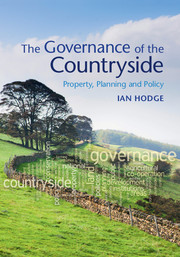Book contents
- Frontmatter
- Contents
- Preface
- Acknowledgements
- List of abbreviations
- Part I Introduction
- Part II Historical models
- 4 Cooperation for production: common fields and enclosure
- 5 Delivering diversity: the Great Estates and the management of the land
- Part III Governance under sectoral policies
- Part IV Alternative approaches to governance
- Part V Conclusions
- References
- Index
4 - Cooperation for production: common fields and enclosure
from Part II - Historical models
Published online by Cambridge University Press: 05 February 2016
- Frontmatter
- Contents
- Preface
- Acknowledgements
- List of abbreviations
- Part I Introduction
- Part II Historical models
- 4 Cooperation for production: common fields and enclosure
- 5 Delivering diversity: the Great Estates and the management of the land
- Part III Governance under sectoral policies
- Part IV Alternative approaches to governance
- Part V Conclusions
- References
- Index
Summary
The law declares the man a felon
Who steals the goose from off the common
But leaves the greater villain lose
Who steals the common from the goose.
Anon4.1 The common field system
We are familiar with the predominant arrangements of private property where each piece of land is owned and farmed independently by an individual farmer. In fact, as we have seen already, there are many variations to this rather simplified description of the way in which land is owned and occupied in the present day. However, this type of private ownership is neither inevitable nor fixed. In this chapter, we explore a particular type of collective governance of rural land with a view to challenging the inevitability of an increasingly privatised countryside. To do this, we use the historic example of the common field system practised across Europe over a long period of time, although we might have looked at contemporary examples of common property such as those analysed extensively by Elinor Ostrom (1990). First, we look at the operation of the common field system and the institutions that were developed in order to address the challenges of collective management. We then look at the decline of the system through Enclosures and the elements that remain in contemporary UK.
The history of land use includes a number of examples of cooperative production, the most dominant in its time being the common field systems that operated in Europe and in parts of Asia, lasting for as much as a thousand years in Britain (Orwin, 1949, pp. 19, 23). The origins of common fields in Britain are uncertain. Oosthuizen (2011) argues that small open fields under collective cultivation, but irregular in both layout and management, can be found in prehistoric and Roman Britain. Evidence from Anglo-Saxon charters suggests that a system of common fields may have originated in central England in the ‘long’ eighth century between 670 and 840 AD, evolving to a full flowering in the post-Conquest period (Oosthuizen, 2007, 2013).
In practice, the specifics of the arrangements have varied considerably between different times and different places, but there are certain recognisable basic components to the common field system. Dahlman (1980) defines a stylised system to represent the basic model for analysis and this is the focus of our discussion in this chapter.
- Type
- Chapter
- Information
- The Governance of the CountrysideProperty, Planning and Policy, pp. 65 - 84Publisher: Cambridge University PressPrint publication year: 2016



